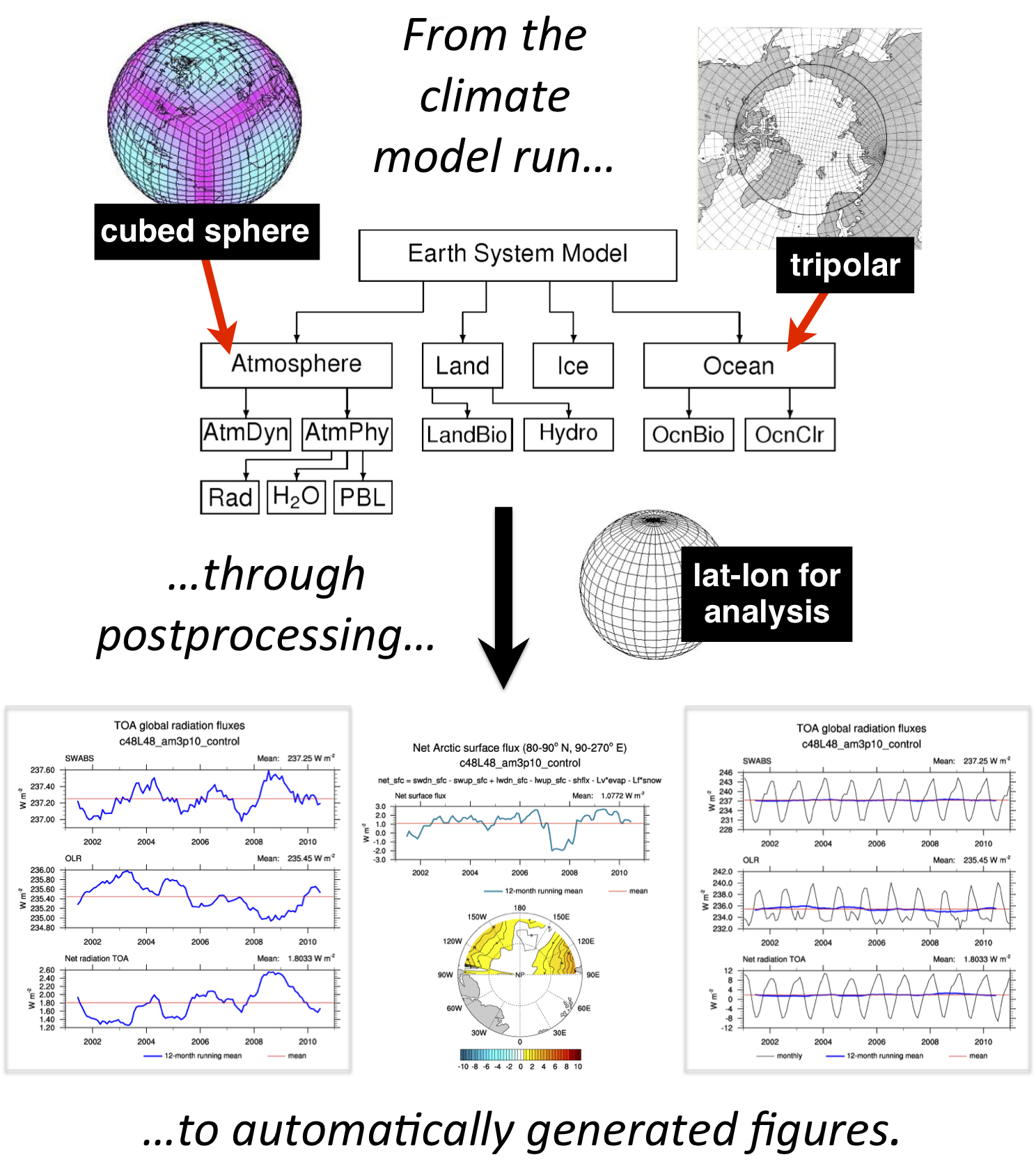Modeling Systems Group
Modeling Systems Group focuses on:
Computing and Framework
The development of tools and methodologies to facilitate the modeling process, developing a framework that provides infrastructure and tools to structure climate model codes and facilitate many common tasks. Our framework, the Flexible Modeling System, was one of the first to be developed — in 1998 — and is still in use and development today, using new architectures and new algorithms. An important addition, the implementation of a cubed-sphere grid, has provided the infrastructure needed for the scientific development of GFDL’s new finite-volume dynamical core, a new ocean model (MOM6), and new coupled models, such as CM3 and CM4. For more information, see GFDL Modeling Framework: The Flexible Modeling System
Runtime Environment

The development of a runtime environment is intended to reduce the time to get the model up and running, and at the same time reduce errors caused by manual manipulation of configuration files. Our runtime environment, the FMS Runtime environment, encapsulates complete model configurations in a single file, from submission of model runs, archiving model outputs, to post-processing the output data and creating automated analysis figures. A goal of this effort is to achieve reproducibility of a model run, a central element of the scientific method. For more information, see GFDL Runtime Environment: The FMS Runtime Environment
Data and Metadata
A registry of metadata assists climate modelers and scientists in the tasks of building and running climate models and analyzing the resulting model-generated datasets. A primary goal of this area of research and work is to unify access to climate modeling components and output datasets by allowing descriptions of both to exist in a central metadata registry. GFDL Curator is a software infrastructure that holds such metadata and provides end-to-end management from model configuration to archived dataset, and queries an archived dataset to provide complete scientific information on the from which model it emanates. It is used by GFDL scientists to collaborate in the development of new scientific models, as well as publishing datasets to the outside climate community. For more information, see GFDL Curator: The FRE Curator
Data Portal
Public data sets from GFDL model simulations are made available through the GFDL Data Portal. The Data Portal allows you to download files, display data files attributes, and graphically display the data.
Public Releases
GFDL’s Flexible Modeling Infrastructure and several model codes have been released publicly.
Select Publications
- Balaji, V, 2013: Scientific computing in the age of complexity. XRDS, 19(3), DOI:10.1145/2425676.2425684.
- Guilyardi, E, and Venkatramani Balaji, et al., May 2013: Documenting climate models and their simulations. Bulletin of the American Meteorological Society, 94(5), DOI:10.1175/BAMS-D-11-00035.1.
- Balaji, Venkatramani, 2012: The Flexible Modeling System. Earth System Modeling – Volume 3, Coupling Software and Strategies, (S. Valcke, R. Redler, and R. Budich, Eds.), Springer Berlin Heidelberg, SpringerBriefs in Earth System Sciences, 33?41, DOI:10.1007/978-3-642-23360-9_5.
- Valcke, S, and Venkatramani Balaji, et al., December 2012: Coupling technologies for Earth System Modeling. Geoscientific Model Development, 5(6), DOI:10.5194/gmd-5-1589-2012.
- Balaji, Venkatramani, R Redler, and R Budich, 2013: Earth System Modeling – Volume 4: IO and Postprocessing , Heidelberg: Springer. Doi:10.1007/978-3-642-36464-8.
- Balaji, Venkatramani, 2012: Code Parallelisation On Massively Parallel Machines. Earth System Modelling – Volume 2, Algorithms, Code Infrastructure and Optimisation, (L. Bonaventura, R. Redler, and R. Budich, Eds.), Springer Berlin Heidelberg, SpringerBriefs in Earth System Sciences, Vol. 1, 77-88, DOI:10.1007/978-3-642-23831-4_8.
- Balaji, Venkatramani, and Amy R Langenhorst, 2012: ESM Workflow. Earth System Modeling – Volume 5, Tools for Configuring, Building and Running Models, (R. Ford, G. Riley, R. Budich, and R. Redler, Eds.), Springer Berlin Heidelberg, SpringerBriefs in Earth System Sciences, 5-13, DOI:10.1007/978-3-642-23932-8_2.
- Lawrence, B N., and V Balaji, et al., November 2012: Describing Earth System Simulations with the Metafor CIM. Geoscientific Model Development, 5(6), DOI:10.5194/gmd-5-1493-2012.
- Guilyardi, E, and V Balaji, et al., May 2011: The CMIP5 model and simulation documentation: A new standard for climate modelling metadata. Clivar Exchanges, 16(2), 42-46.
- Dunlap, R, L Mark, S Rugaber, and V Balaji, et al., November 2008: Earth system curator: metadata infrastructure for climate modeling. Earth Science Informatics, 1(3), DOI:10.1007/s12145-008-0016-1.


